Chaperones are a family of proteins that play a vital role in the stabilization of unfolded proteins. This stabilization aids in many processes such as translocation, degradation, and folding.

Calnexin, a chaperone, characterized by assisting protein folding and quality control, ensuring that only properly folded and assembled proteins proceed further along the secretory pathway. Image Credit: ibreakstock / Shutterstock
Protein Folding
The beginning of protein synthesis is carried out by ribosomes that synthesize a linear chain of amino acids called a polypeptide chain. The mRNA specifies the sequence of the amino acids.
Each amino acid within this polypeptide chain has a different property. For example, glycine is highly hydrophobic, whilst arginine is very hydrophilic. These properties dictate the three-dimensional structure of the protein. The hydrophobic amino acids need to be kept within the interior of the protein whilst the hydrophilic amino acids need to be on the exterior of the protein.
Hydrogen bonds bind to the polypeptide chains to form secondary structure of proteins that is the alpha helices and beta sheets. The stacking of these helices and sheets forms the tertiary structure.
Protein folding must be maintained in their three-dimensional shape and should not aggregate or degrade. Unfolded or misfolded proteins give way to a host of diseases.
Chaperones - folding helpers in the cell
The Role of Chaperones in Protein Folding
Chaperones are a group of proteins that have functional similarity and assist in protein folding. They are proteins that have the ability to prevent non-specific aggregation by binding to non-native proteins.
There are several families of chaperones and each possesses different functions. Example of chaperon proteins are the “heat shock proteins” (Hsps).
The name Hsp was given after these proteins were discovered in bacterium. These bacteria produced more of these proteins in stressful conditions, such as higher temperatures, pH variation and hypoxic conditions. Two examples of Hsps are Hsp70 and Hsp60.
Hsp70
The Hsp70 chaperone proteins are folding catalysts that assist in many kinds of folding processes such as refolding or misfolding of aggregated proteins, and folding and assembling of new proteins. These proteins are monomeric and contain two different domains called the N and C terminals. The N terminal contains ATPase whilst the C terminal binds to the substrate. ATP hydrolysis within the N terminal allows the C terminal to open and bind to the substrate.
Hsp70 recognizes a region of the unfolded polypeptide chain termed the “extended region”. This extended region contains many hydrophobic residues. Binding of Hsp70 prevents the aggregation of these proteins.
Hsp60
Like Hsp70, Hsp60 chaperone proteins also have the ability to bind to exposed hydrophobic residues to form aggregates that are stable but inactive. These proteins are not involved in preventing aggregation, but instead function to quarantine and isolate unfolded proteins. The isolation also prevents the polypeptide chain from aggregating into clumps with other chains within the cytoplasm.
Hsp 60 contains 14 different proteins components. These proteins form two rings, each made of 7 proteins, which are placed on top of each other. Unfolded proteins within these rings are then able to fold without aggregating with other unfolded proteins and without interference from Hsp70.
As seen in Hsp70, Hsp60 also has two different forms. The first state is the binding form, in which ATP is bound and the unfolded proteins can enter the hole between the two rings. Hydrolysis of ATP then initiates the formation of an enclosed state, called the folding-active state. This conformational change prevents the protein from leaving and encourages folding of the proteins. This enclosed state last for around 15 seconds before the conformation changes back and the properly folded protein is released into the cytoplasm.
Chaperones play a very important role within the cytoplasm preventing aggregation and promoting various important functions such as translocation, degradation, and suitable protein folding.
Loss or mutations of these chaperones give rise to several diseases. An example of a group of genetic diseases associated with mutated chaperones are multisystem proteinopathies (MSP) that affect a wide range of bodily functions involving the muscle, bone and nervous system.
Therapeutic Application of Hsp Inhibitors
Of late, Hsp inhibitors such as Hsp 90 inhibitors are being used to inhibit signaling pathways that are responsible for the growth and proliferation of tumor cells.
Chemical chaperones have been used to treat metabolic diseases. For instance, accumulation of unfolded or misfolded proteins can cause endoplasmic reticulum (ER) stress. To relieve this ER stress, small molecules called chemical chaperones are used that promote proper protein folding. The positive influences of chemical chaperones on ER-stress-related pathologies render them to be useful to treat metabolic disorders such as type 2 diabetes, obesity, and atherosclerosis.
In addition to chaperones being essential stress proteins for maintenance of other proteins and cell survival, their application in the therapeutic area has increased dramatically.
Further Reading
Last Updated: Aug 22, 2023